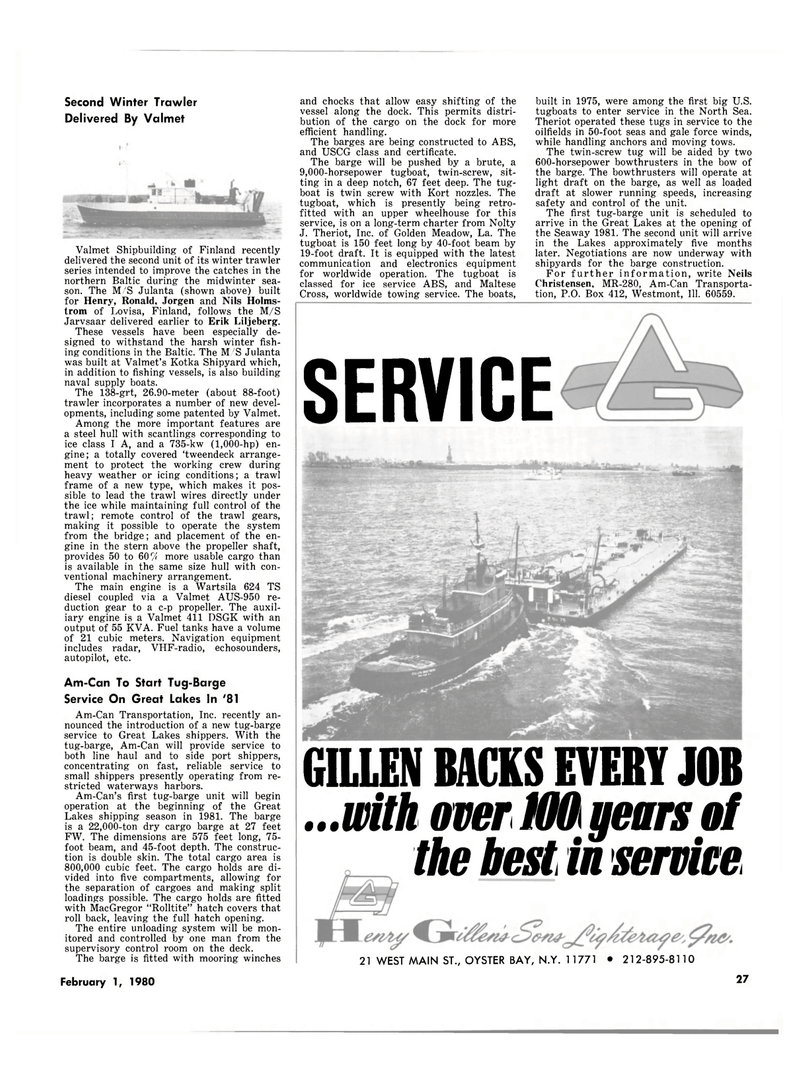
Page 23: of Maritime Reporter Magazine (February 1980)
Read this page in Pdf, Flash or Html5 edition of February 1980 Maritime Reporter Magazine
Second Winter Trawler
Delivered By Valmet
Valmet Shipbuilding of Finland recently- delivered the second unit of its winter trawler series intended to improve the catches in the northern Baltic during the midwinter sea- son. The M S Julanta (shown above) built for Henry, Ronald, Jorgen and Nils Holms- trom of Lovisa, Finland, follows the M/S
Jarvsaar delivered earlier to Erik Liljeberg.
These vessels have been especially de- signed to withstand the harsh winter fish- ing conditions in the Baltic. The M S Julanta was built at Valmet's Kotka Shipyard which, in addition to fishing vessels, is also building naval supply boats.
The 138-grt, 26.90-meter (about 88-foot) trawler incorporates a number of new devel- opments, including some patented by Valmet.
Among the more important features are a steel hull with scantlings corresponding to ice class I A, and a 735-kw (1,000-hp) en- gine; a totally covered 'tweendeek arrange- ment to protect the working crew during heavy weather or icing conditions; a trawl frame of a new type, which makes it pos- sible to lead the trawl wires directly under the ice while maintaining full control of the trawl; remote control of the trawl gears, making it possible to operate the system from the bridge; and placement of the en- gine in the stern above the propeller shaft, provides 50 to 60 r/< more usable cargo than is available in the same size hull with con- ventional machinery arrangement.
The main engine is a Wartsila 624 TS diesel coupled via a Valmet AUS-950 re- duction gear to a c-p propeller. The auxil- iary engine is a Valmet 411 DSGK with an output of 55 KVA. Fuel tanks have a volume of 21 cubic meters. Navigation equipment includes radar, VHF-radio, echosounders, autopilot, etc.
Am-Can To Start Tug-Barge
Service On Great Lakes In '81
Am-Can Transportation, Inc. recently an- nounced the introduction of a new tug-barge service to Great Lakes shippers. With the tug-barge, Am-Can will provide service to both line haul and to side port shippers, concentrating on fast, reliable service to small shippers presently operating from re- stricted waterways harbors.
Am-Can's first tug-barge unit will begin operation at the beginning of the Great
Lakes shipping season in 1981. The barge is a 22,000-ton dry cargo barge at 27 feet
FW. The dimensions are 575 feet long, 75- foot beam, and 45-foot depth. The construc- tion is double skin. The total cargo area is 800,000 cubic feet. The cargo holds are di- vided into five compartments, allowing for the separation of cargoes and making split loadings possible. The cargo holds are fitted with MacGregor "Rolltite" hatch covers that roll back, leaving the full hatch opening.
The entire unloading system will be mon- itored and controlled by one man from the supervisory control room on the deck.
The barge is fitted with mooring winches
February 1, 1980 and chocks that allow easy shifting of the vessel along the dock. This permits distri- bution of the cargo on the dock for more efficient handling.
The barges are being constructed to ABS, and USCG class and certificate.
The barge will be pushed by a brute, a 9,000-horsepower tugboat, twin-screw, sit- ting in a deep notch, 67 feet deep. The tug- boat is twin screw with Kort nozzles. The tugboat, which is presently being retro- fitted with an upper wheelhouse for this service, is on a long-term charter from Nolty
J. Theriot, Inc. of Golden Meadow, La. The tugboat is 150 feet long by 40-foot beam by 19-foot draft. It is equipped with the latest communication and electronics equipment for worldwide operation. The tugboat is classed for ice service ABS, and Maltese
Cross, worldwide towing service. The boats, built in 1975, were among the first big U.S. tugboats to enter service in the North Sea.
Theriot operated these tugs in service to the oilfields in 50-foot seas and gale force winds, while handling anchors and moving tows.
The twin-screw tug will be aided by two 600-horsepower bowthrusters in the bow of the barge. The bowthrusters will operate at light draft on the barge, as well as loaded draft at slower running speeds, increasing safety and control of the unit.
The first tug-barge unit is scheduled to arrive in the Great Lakes at the opening of the Seaway 1981. The second unit will arrive in the Lakes approximately five months later. Negotiations are now underway with shipyards for the barge construction.
For further information, write Neils
Christensen, MR-280, Am-Can Transporta- tion, P.O. Box 412, Westmont, 111. 60559.
SERVICE
GILLEN BACKS EVERY JOB ...with over 100 years of the best in service 21 WEST MAIN ST., OYSTER BAY, N.Y. 1 1771 • 212-895-8110 27

 22
22

 24
24
